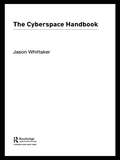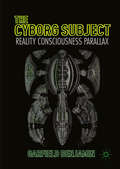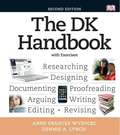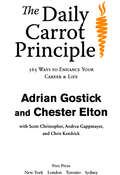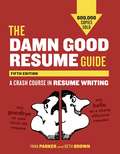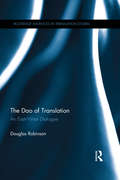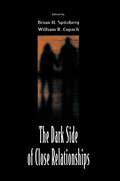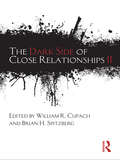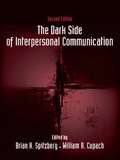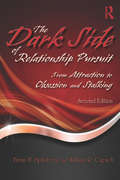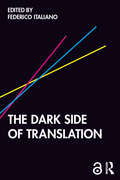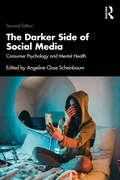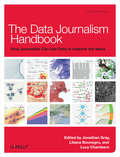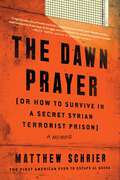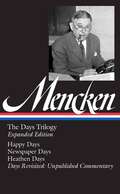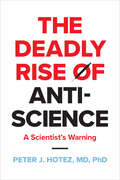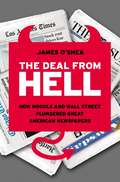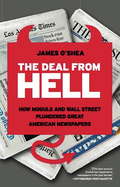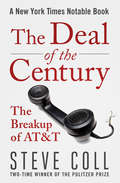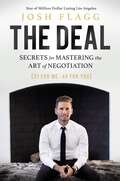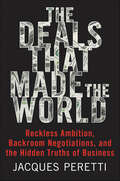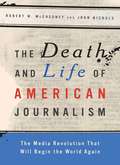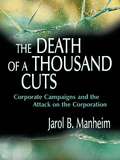- Table View
- List View
The Cyberspace Handbook
by Jason WhittakerThe Cyberspace Handbook is a comprehensive guide to all aspects of new media, information technologies and the internet. It gives an overview of the economic, political, social and cultural contexts of cyberspace, and provides practical advice on using new technologies for research, communication and publication. The Cyberspace Handbook includes: *a glossary of over eighty key terms*a list of over ninety web resources for news and entertainment, new media and web development, education and reference, and internet and web information* specialist chapters on web design and journalism and writing on the web*Over thirty illustrations of internet material and software applications.Jason Whittaker explores how cyberspace has been constructed, how it is used and extends into areas as different as providing us immediate news or immersive games and virtual technologies for areas such as copyright and cybercrime, as well as key skills in employing the internet for research or writing and designing for the Web.
The Cyborg Subject
by Garfield BenjaminThis book outlines a new conception of the cyborg in terms of consciousness as the parallax gap between physical and digital worlds. The contemporary subject constructs its own internal reality in the interplay of the Virtual and the Real. Reinterpreting the work of Slavoj Žižek and Gilles Deleuze in terms of the psychological and ontological construction of the digital, alongside the philosophy of quantum physics, this book offers a challenge to materialist perspectives in the fluid cyberspace that is ever permeating our lives. The inclusion of the subject in its own epistemological framework establishes a model for an engaged spectatorship of reality. Through the analysis of online media, digital art, avatars, computer games and science fiction, a new model of cyborg culture reveals the opportunities for critical and creative interventions in the contemporary subjective experience, promoting an awareness of the parallax position we all occupy between physical and digital worlds.
The DK Handbook Second Edition with Exercises
by Dennis A. Lynch Anne Frances WysockiTransforming expectations for textbooks, The DK Handbook with Exercises 2/e presents information in newly accessible, scientifically tested, and student-friendly ways. Never before seen in the handbook market, The DK Handbook's design is a true marriage of visual and textual content, in which each topic is presented in self-contained, two-page spreads for at-a-glance referencing. Explanations are concise and "chunked" to be more approachable and appealing for today's readers, and accompanying visuals truly teach - making concepts and processes visible to students. The ground-breaking layout creates a consistent look and feel that helps students connect with the material, find information, and recognize solutions to writing problems they often don't have names for.
The Daily Carrot Principle: 365 Ways to Enhance Your Career and Life
by Adrian Gostick Chester EltonFrom the authors of the smash bestseller The Carrot Principle comes an inspiring and lively page-a-day guide to harnessing the remarkable power of the carrot--taking yourself and your team to new heights of success in work and life.Based on their twenty years of experience teaching leaders at Fortune 100 companies, as well as one of the largest research studies ever conducted on workplace satisfaction, Gostick and Elton share a wealth of wisdom about simple but amazingly effective ways to boost your productivity and work satisfaction by setting clear goals, communicating effectively, building trust, and offering recognition in ways that make others feel appreciated and motivated.Each engaging page of The Daily Carrot Principle features a core kernel of wisdom, enlivened by thoughtful and witty quotes from the likes of Thomas Edison, Rosabeth Moss Kanter, Jim Collins, and Oprah Winfrey, plus a bonanza of insights from standout managers and employees the authors have studied. An easy-to-implement "carrot action" ends each page, providing the simple steps to begin applying this wealth of wisdom immediately.Whether you are a business leader, team member, student, mom or dad, or anyone hoping to achieve more in your life, this book will be an inspiring and practical guide to unleashing your hidden potential and leading a richer life.
The Damn Good Resume Guide, Fifth Edition: A Crash Course in Resume Writing
by Beth Brown Yana ParkerOne of the best-selling resume books of all time and a trusted resource for job-seekers for nearly three decades, this edition of The Damn Good Resume Guide has been completely revised and updated for today's marketplace.One of the best-selling resume books of all time and a trusted resource for job-seekers for nearly three decades, this edition of The Damn Good Resume Guide has been completely revised and updated for today's marketplace.The Shortest Distance Between You and Your Next Job For hundreds of thousands of job seekers, The Damn Good Resume Guide has been the go-to resource for writing and refining their resumes to damn near perfection. Filled with savvy advice and written in a straightforward, user-friendly style, The Damn Good Resume Guide will help you zero in on that dream job, then craft a winning resume that gets your foot in the door. This tried-and-true best seller has been fully revised and updated for today's job market, including: Contemporary sample resumes (all of which landed interviews!) with job objectives running the career gamut--from line cook to sales manager, school principal to software engineer.Tips on creating a functional, chronological, or hybrid resume--and advice on choosing which format is best for you.What to include and what to leave out of your resume, so you get the job you really want.Smart ways to deal with gaps in your work history and other less-than-ideal resume scenarios.Instructions for writing cover emails and submitting resumes electronically.How to set up (and excel at) an informational interview.Advice for formatting, polishing, and proofing your resume so that it stands out in the right way.And much more!Follow Parker and Brown's ten easy steps, and you'll be well on your way to a smart, effective, and thoroughly modern resume--a resume that makes you look good and produces results.
The Dao of Translation: An East-West Dialogue (Routledge Advances in Translation and Interpreting Studies)
by Douglas RobinsonThe Dao of Translation sets up an East-West dialogue on the nature of language and translation, and specifically on the "unknown forces" that shape the act of translation. To that end it mobilizes two radically different readings of the Daodejing (formerly romanized as the Tao Te Ching): the traditional "mystical" reading according to which the Dao is a mysterious force that cannot be known, and a more recent reading put forward by Sinologists Roger T. Ames and David L. Hall, to the effect that the Dao is simply the way things happen. Key to Ames and Hall’s reading is that what makes the Dao seem both powerful and mysterious is that it channels habit into action—or what the author calls social ecologies, or icoses. The author puts Daoism (and ancient Confucianism) into dialogue with nineteenth-century Western theorists of the sign, Charles Sanders Peirce and Ferdinand de Saussure (and their followers), in order to develop an "icotic" understanding of the tensions between habit and surprise in the activity of translating. The Dao of Translation will interest linguists and translation scholars. This book will also engage researchers of ancient Chinese philosophy and provide Western scholars with a thought-provoking cross-examination of Eastern and Western perspectives.
The Dark Side of Close Relationships
by William R. Cupach Brain H. SpitzbergThis collection of essays represents a follow-up to the editors' 1994 publication, The Dark Side of Interpersonal Communication. In the preface to that collection of essays, they argued that "To fully understand how people function effectively requires us to consider how individuals cope with social interaction that is difficult, problematic, challenging, distressing, and disruptive." In this companion volume, the focus expands from social interaction to close relationships. Aside from the inherent need to investigate the bad as well as the good of interpersonal relationships, the editors and their colleagues simply find the dark side metaphor to be intellectually arousing. It stimulates investigation of important yet often neglected phenomena, and it especially encourages consideration of the hidden and forbidden, and the paradoxical and ironic elements of human relating. This volume assembles the cutting-edge work of first rate scholars from the ranks of communication, psychology, sociology, and cognate disciplines. As in the previous text, the subject matter and stylistic approaches are diverse, reflecting the broad and interdisciplinary domain that is the dark side of human affairs. The selection of topics is somewhat selective, reflecting only a sample of emerging scholarship in the interdisciplinary study of relationships. These internationally recognized scholars examine various topics related to the dark side, including fatal attractions, jealousy and envy, misunderstanding, gossip, conflict, codependence, sexual coercion, stalking, relationship termination, unrequited love, and mental health problems in relationships. Some chapters present original data and models, whereas others reconfigure the way in which the understandings of relationships can be better understood. In addition, the bookend chapters examine the ideology, nature, and problems of dark side scholarship. Collectively, the scholarly journeys made in this volume are intended to illustrate the complexities--both moral and functional--involved in close relationship processes. The intent is neither to valorize nor demonize the darker aspects of close relationships, but rather to emphasize their importance to the day-to-day "doing" of relationships. Only by accepting such processes as integral to relationships can their role be fully understood.
The Dark Side of Close Relationships II
by William R. Cupach Brian H. SpitzbergThe Dark Side of Close Relationships II is a completely new and up-to-date version of the original volume published in 1998, featuring new topics and authors. The volume showcases cutting-edge work on important topics by prominent scholars in multiple disciplines. It sheds light on the paradoxical, dialectical, and mystifying facets of human interaction, not merely to elucidate dysfunctional relationship phenomena, but to help readers explore and understand it in relation to a broader understanding about relationships. As previous Dark Side investigations have revealed, negative or dysfunctional outcomes can occur in relationships even though positive and functional ones are expected, and at the same time, positive silver linings are often found in some dark relational clouds. Such nuanced approaches are needed to better account for the complexity of close relationships. A unique and provocative collection, this volume will appeal to relationship researchers in communication, social psychology, family studies, and sociology.
The Dark Side of Interpersonal Communication
by William R. Cupach Brian H. SpitzbergThe Dark Side of Interpersonal Communication examines the multifunctional ways in which seemingly productive communication can be destructive—and vice versa—and explores the many ways in which dysfunctional interpersonal communication operates across a variety of personal relationship contexts. This second edition of Brian Spitzberg and William Cupach’s classic volume presents new chapters and topics, along with updates of several chapters in the earlier edition, all in the context of surveying the scholarly landscape for new and important avenues of investigation. Offering much new content, this volume features internationally renowned scholars addressing such compelling topics as uncertainty and secrecy in relationships; the role of negotiating self in cyberspace; criticism and complaints; teasing and bullying; infidelity and relational transgressions; revenge; and adolescent physical aggression toward parents. The chapters are organized thematically and offer a range of perspectives from both junior scholars and seasoned academics. By posing questions at the micro and macro levels, The Dark Side of Interpersonal Communication draws closer to a perspective in which the darker sides and brighter sides of human experience are better integrated in theory and research. Appropriate for scholars, practitioners, and students in communication, social psychology, sociology, counseling, conflict, personal relationships, and related areas, this book is also useful as a text in graduate courses on interpersonal communication, ethics, and other special topics.
The Dark Side of Relationship Pursuit: From Attraction to Obsession and Stalking
by William R. Cupach Brian H. SpitzbergAwards and Praise for the first edition: Recipient of the 2006 International Association for Relationship Research (IARR) Book Award "This text, as it presently stands, is THE go-to text for stalking researchers. That is my opinion and the opinion of multiple fellow scholars I know in the field. It rarely sits on my shelf, but rather is a constant reference on my desk. I can always count on these authors to have done an extensive review of literature. I thought I was thorough, but they are always providing me with new references."--Dr. H. Colleen Sinclair, Associate Professor of Psychology, Mississippi State University "Cupach and Spitzberg provide the reader with a multidisciplinary framework for understanding the nature and impact of unwanted relationship pursuits. This book is an excellent resource for students and professionals alike who seek to gain knowledge about unwanted relational pursuits and stalking." —Journal of Couple & Relationship Therapy The Dark Side of Relationship Pursuit provides historical and definitional frames for studying unwanted relationship pursuit, and considers the role of the media, law, and social science research in shaping today’s conceptualizations of stalking. The volume integrates research from diverse contributing fields and disciplines, providing a thorough summary and assessment of current knowledge on stalking and obsessive pursuit. Building on the foundation of the award-winning first edition, this revision considers assessment issues, offers an expanded analysis of the meta-analysis data set, and includes coverage of intercultural and international factors. As an increasing number of scholarly disciplines and professional fields study stalking and other forms of obsessive relationship pursuit, this book is a must-have resource for examining interpersonal conflict, social and personal relationships, domestic violence, unrequited love, divorce and relational dissolution, and harassment. It also has much to offer researchers, counselors, and professionals in psychology, counseling, criminal justice, sociology, psychiatry, forensic evaluation, threat assessment, and law enforcement.
The Dark Side of Translation
by Robertson Federico ItalianoWe tend to consider translation as something good, virtuous and bright, but it can also function as an instrument of concealment, silencing and misdirection—as something that darkens and obscures. Propaganda, misinformation, narratives of trauma and imagery of the enemy—to mention just a few of the negative phenomena that shape our lives—show patterns of communication in which translation either functions as a weapon or constitutes a space of conflict. But what does this dark side of translation look like? How does it work? Ground-breaking in its theoretical conception and pioneering in its thematic approach, this book unites international scholars from a range of disciplines including philosophy, translation studies, literary theory, ecocriticism, game studies, history and political science. With examples that illustrate complex theoretical and philosophical issues, this book also has a major focus on the translational dimension of ecology and climate change. Transdisciplinary and topical, this book is key reading for researchers, scholars and advanced students of translation studies, literature and related areas.
The Darker Side of Social Media: Consumer Psychology and Mental Health
by Angeline Close ScheinbaumThe Darker Side of Social Media: Consumer Psychology and Mental Health takes a research-based, scientific approach to examining problematic issues and outcomes that are related to social media use by consumers. Now in its second edition, it relies on psychological theories to help explain or predict problematic online behavior within the social media landscape through the lens of mental health.With an aim to provide solutions, the authors spotlight the key issues affecting consumer well-being and mental health due to the omnipresence and overuse of social media. The book dissects the unintended consequences of too much social media use, specifying key problems like disconnection anxiety, eating disorders, online fraud, cyberbullying, the dark web, addiction, depression, self-discrepancies, and serious privacy concerns (especially impacting children or young people). The book provides grapples with mental health disorders such as anxiety, depression, self-harm, and eating disorders that can be intensified by, or correlated with, too much social media use. The authors meticulously review the various facets of the darker side of online presence and propose actionable solutions for each of the problems stated, providing scholars with a conceptual model with propositions for continued research.This international exploration of social media is a must-read for students of marketing, advertising, and public relations, as well as scholars/managers of business, marketing, psychology, communication, management, and sociology. It will also be of interest to social media users, those navigating new media platforms parents, policymakers, and practitioners.
The Data Journalism Handbook: How Journalists Can Use Data to Improve the News
by Jonathan Gray Lucy Chambers Liliana BounegruWhen you combine the sheer scale and range of digital information now available with a journalist’s "nose for news" and her ability to tell a compelling story, a new world of possibility opens up. With The Data Journalism Handbook, you’ll explore the potential, limits, and applied uses of this new and fascinating field.This valuable handbook has attracted scores of contributors since the European Journalism Centre and the Open Knowledge Foundation launched the project at MozFest 2011. Through a collection of tips and techniques from leading journalists, professors, software developers, and data analysts, you’ll learn how data can be either the source of data journalism or a tool with which the story is told—or both.Examine the use of data journalism at the BBC, the Chicago Tribune, the Guardian, and other news organizationsExplore in-depth case studies on elections, riots, school performance, and corruptionLearn how to find data from the Web, through freedom of information laws, and by "crowd sourcing"Extract information from raw data with tips for working with numbers and statistics and using data visualizationDeliver data through infographics, news apps, open data platforms, and download links
The Dawn Prayer: A Memoir
by Matthew Schrier"What is your name?" asked General Mohammad. "Matthew," I said. I had stopped saying Matt a while ago because it means &‘dead' in Arabic. On New Year's Eve in 2012, Matthew Schrier was headed home from Syria, where he'd been photographing the intense combat of the country's civil war. Just 45 minutes from the safety of the Turkish border, he was taken prisoner by the al Nusra Front—an organization the world would come to know as the Syrian branch of Al Qaeda. Over the next seven months he would endure torture and near starvation in six brutal terrorist prisons. He'd face a daily struggle just to survive. And, eventually, he'd escape. In this gripping, raw, and surprisingly funny memoir, Schrier details the horrifying and frequently surreal experience of being a slight, wisecracking Jewish guy held captive by the world's most violent Islamic extremists. Managing to keep his heritage a secret, Schrier used humor to develop relationships with his captors—and to keep himself sane during the long months of captivity. The Dawn Prayer (Or How to Survive in a Secret Syrian Terrorist Prison): A Memoir is a tale of patriotism and unimaginable bleakness shot through with light . . . of despair and friendship, sacrifice and betrayal, in a setting of bombed-out buildings and shifting alliances. It's the story of the first Westerner to escape al Qaeda—not a battle-hardened soldier, but an ordinary New Yorker who figured out how to set his escape plan in motion from a scene in Jurassic Park. From the prisoners' fiercely competitive hacky sack games and volleyball tournaments (played using a ball made of shredded orange peels and a shoelace) to his own truly nail-biting outbreak, Matthew Schrier's story is unforgettable—and one you won't want to miss.
The Days Trilogy
by H. L. MenckenA major literary event: Mencken’s dazzling autobiography, with 200 pages of his own never-before-published commentary and photos. In 1936, at the age of fifty-five, H. L. Mencken published a reminiscence about his boyhood in The New Yorker, beginning a long and magnificent adventure in autobiography by America’s greatest journalist. Mencken went on to gather his childhood recollections in Happy Days (1940), a richly detailed, poignant account of growing up in Baltimore. A critical and popular success, the book surprised many with its glimpses of a less curmudgeonly Mencken, and there soon followed the absorbing sequels Newspaper Days (1941), charting his rise at the Baltimore Herald from cub reporter to editor, and Heathen Days (1943), recounting his varied excursions as journalist and public figure, including his coverage of the Scopes trial in 1925. But unknown to the legions of Days books’ admirers, Mencken continued to add to them after publication, annotating and expanding each volume in typescripts sealed to the public for twenty-five years after his death. Until now, most of this material—often more frank and unvarnished than the original Days books—has never been published. Containing nearly 200 pages of previously unseen writing, and illustrated with photographs from Mencken’s archives, many taken by Mencken himself, this expanded and definitive edition of the Days trilogy is a cause for celebration.
The Deal from Hell
by James O'SheaIn 2000, after the Tribune Company acquired Times Mirror Corporation, it comprised the most powerful collection of newspapers in the world. How then did Tribune nosedive into bankruptcy and public scandal? <P><P>In The Deal From Hell, veteran Tribune and Los Angeles Times editor James O'Shea takes us behind the scenes of the decisions that led to disaster in boardrooms and newsrooms from coast to coast, based on access to key players, court testimony, and sworn depositions. The Deal From Hell is a riveting narrative that chronicles how news industry executives and editors--convinced they were acting in the best interests of their publications--made a series of flawed decisions that endangered journalistic credibility and drove the newspapers, already confronting a perfect storm of political, technological, economic, and social turmoil, to the brink of extinction.
The Deal from Hell: How Moguls and Wall Street Plundered Great American Newspapers
by James O'SheaIn 2000, after the Tribune Company acquired Times Mirror Corporation, it comprised the most powerful collection of newspapers in the world. How then did Tribune nosedive into bankruptcy and public scandal? In The Deal From Hell, veteran Tribune and Los Angeles Times editor James O'Shea takes us behind the scenes of the decisions that led to disaster in boardrooms and newsrooms from coast to coast, based on access to key players, court testimony, and sworn depositions.The Deal From Hell is a riveting narrative that chronicles how news industry executives and editors--convinced they were acting in the best interests of their publications--made a series of flawed decisions that endangered journalistic credibility and drove the newspapers, already confronting a perfect storm of political, technological, economic, and social turmoil, to the brink of extinction.
The Deal of the Century: The Breakup of AT&T
by Steve CollA New York Times–bestselling author&’s &“superbly reported&” account of the dismantling of the world&’s largest corporation (The Washington Post). Written by the two-time Pulitzer Prize–winning author of Ghost Wars and Private Empire, The Deal of the Century chronicles the decade-long war for control of AT&T. When the US Department of Justice brought an antitrust lawsuit against AT&T in 1974, the telecommunications giant held a monopoly on phone service throughout the country. Over the following decade, an army of lawyers, executives, politicians, and judges spent countless hours clashing over what amounted to the biggest corporate breakup in American history. From boardroom to courtroom, Steve Coll untangles the myriad threads of this complex and critical case and gives readers &“an excellent behind-the-scenes look&” at the human drama involved in the remaking of an entire industry (The Philadelphia Inquirer). Hailed by the New York Times Book Review as &“rich, intricate and convincing,&” The Deal of the Century is the definitive narrative of a momentous turning point in the way America does business.
The Deal: Secrets for Mastering the Art of Negotiation
by Josh FlaggLEARN STRATAGIES FOR SUCCESSFUL DEAL MAKINGStar of the hit show Million Dollar Listing Los Angeles, Josh Flagg shares his secrets to mastering any negotiation in any industry and at any level.Throughout his career, Josh Flagg has faced off with challengers of all kinds in negotiations over the world&’s most expensive and sought-after real estate. He has seen and put into practice what works and identified the &“common tricks&” that don&’t. Josh has curated ten rules that, when applied to any deal, will significantly increase your chance of success, and make you the master negotiator your clients need you to be. Sample rules include:Rule #1: Don&’t Sell Garbage- you are what you sell.Rule #2: You Only Have One Client- focus on the one you&’re with.Rule #3: Up Your Attitude- be the person people want to represent them.Rule #8: Play the Psychologist- you are your client&’s best friend.Rule #10: Know Your Worth- you are your best advocate.If you want to be the best, you have to look and act like the best. Josh learned this rule young and has applied it to every client relationship he has ever had. He began his real estate career as a student at Beverly Hills High School—swung big and hit—landing him in the perfect position to take on some of LA&’s largest, most exclusive real estate listings and, eventually, a spot on Million Dollar Listing Los Angeles. Apply the lessons in the book to become the negotiator who closes million-dollar deals.
The Deals that Made the World: Reckless Ambition, Backroom Negotiations, and the Hidden Truths of Business
by Jacques Peretti"Excellent. ... Impressive." —Financial TimesAn award-winning investigative journalist takes us inside the ten business deals that have transformed the modern worldWe tend to think of our world as controlled by forces we basically understand, primarily the politicians we elect. But in The Deals That Made the World, Jacques Peretti makes a provocative and quite different argument: much of the world around us—from the food we eat to teh products we buy to the medications we take—is shaped by private negotiations and business deals few of us know about.The Deals That Made the World takes us inside the sphere of these powerful players, examining ten groundbreaking business deals that have transformed our modern economy. Peretti reveals how corporate executives engineered an entire diet industry built on failure; how PayPal conquered online payments (and the specific behavioral science that underpins its success); and how pharmaceutical executives concocted a plan to successfully market medications to healthy people.For twenty years, Peretti has interviewed the people behind the decisions that have altered our world, from the CEOs of multinational corporations to politicians, economists, and scientists. Drawing on his vast knowledge, Peretti reveals a host of fascinating and startling connections, from how Wall Street's actions on food commodities helped spark the Arab Spring to the link between the AIDS epidemic in 1980s San Francisco and the subprime mortgage crisis of 2008. Touching upon tech, finance, artificial intelligence, and the other levers of power in a postglobalization environment, Peretti offers a compelling way to understand the last hundred years—and a suggestion of what the next hundred might hold.An essential book for anyone seeking to understand the hidden forces that shape our modern economy, The Deals That Made the World is illuminating and surprising—and an immensely fun read.
The Death and Life of American Journalism
by Robert W. Mcchesney Nichols JohnDaily newspapers are closing across America. Washington bureaus are shuttering; whole areas of the federal government are now operating with no press coverage. International bureaus are going, going, gone. Journalism, the counterbalance to corporate and political power, the lifeblood of American democracy, is not just threatened. It is in meltdown. In The Death and Life of American Journalism, Robert W. McChesney, an academic, and John Nichols, a journalist, who together founded the nation’s leading media reform network, Free Press, investigate the crisis. They propose a bold strategy for saving journalism and saving democracy, one that looks back to how the Founding Fathers ensured free press protection with the First Amendment and provided subsidies to the burgeoning print press of the young nation.
The Death and Life of American Journalism: The Media Revolution That Will Begin the World Again
by John Nichols Robert McchesneyAmerican journalism is collapsing as newspapers and magazines fail and scores of reporters are laid off across the country. Conventional wisdom says the Internet is to blame, but veteran journalists and media critics Robert W. McChesney and John Nichols disagree. The crisis of American journalism predates the Great Recession and digital media boom. What we are witnessing now is the end of the commercial news model and the opportune moment for the creation of a new system of independent journalism, one subsidized by the public and capable of safeguarding our democracy.
The Death of A Thousand Cuts: Corporate Campaigns and the Attack on the Corporation
by Jarol B. ManheimA corporate campaign is an organized assault on the reputation of a company that has offended some interest group. Although corporate campaigns often involve political, economic, and legal tactics, they are centered around the media, where protagonists attempt to redefine the image--and undermine the reputation--of the target company. It is a strategy most frequently employed by unions but is also employed by special interests, such as environmental or human rights groups. Sometimes it is even employed by one corporation against another. It is a rapidly growing phenomenon that is still unknown to the general public, to most academics and journalists, and is rarely understood by the corporations that find themselves on the firing line. The Death of a Thousand Cuts argues and demonstrates that corporate campaigns are a distinctive phenomenon whose manifestations are today ubiquitous in both the marketplace and the media. This volume examines, in considerable detail, the history, strategy, tactics, effects, consequences, and likely future directions of the corporate campaign and of its nonlabor-based cousin, the anticorporate campaign. The book is based on ample sources and methods, among them an extensive review and analysis of media coverage, news releases, previous scholarship, union publications, campaign materials, interviews and conversations with individuals who have experienced corporate campaigns, public presentations by labor leaders and others, correspondence, Internet postings, case law summaries, documents, videotapes, and other materials. Through original data and interpretation, this book adds context and integration to these materials thus giving them new meaning. Key features of this outstanding new book include: * A thorough and clear explanation of what a corporate campaign is and how it differs from other more mundane "public relations" campaigns. * A detailed examination of strategies and tactics that includes their historical development. Some of the more high profile target companies in recent years include Coca-Cola, Microsoft, Caterpillar, Campbell's Soup, Federal Express, General Dynamics, Home Depot, International Paper, K-Mart, Nike, Texaco, Walmart, Starbucks, and UPS. * Hundreds of examples that help explain such contemporary events as the anti-sweatshop movement on college campuses, the living wage movement, and the protests against the World Trade Organization, International Monetary Fund, and World Bank. * A lengthy appendix contains abbreviated descriptions of nearly 200 corporate campaigns waged by labor unions and various advocacy groups since the idea of the corporate campaign was first developed in the 1960's.
The Death of Ben Linder: The Story of a North American in Sandinista Nicaragua
by Joan KruckewittIn 1987, the death of Ben Linder, the first American killed by President Reagan's "freedom fighters" -- the U.S.-backed Nicaraguan Contras -- ignited a firestorm of protest and debate. In this landmark first biography of Linder, investigative journalist Joan Kruckewitt tells his story. In the summer of 1983, a 23-year-old American named Ben Linder arrived in Managua with a unicycle and a newly earned degree in engineering. In 1986, Linder moved from Managua to El Cuá, a village in the Nicaraguan war zone, where he helped form a team to build a hydroplant to bring electricity to the town. He was ambushed and killed by the Contras the following year while surveying a stream for a possible hydroplant. In 1993, Kruckewitt traveled to the Nicaraguan mountains to investigate Linder's death. In July 1995. she finally located and interviewed one of the men who killed Ben Linder, a story that became the basis for a New Yorker feature on Linder's death. Linder's story is a portrait of one idealist who died for his beliefs, as well as a picture of a failed foreign policy, vividly exposing the true dimensions of a war that forever marked the lives of both Nicaraguans and Americans.
